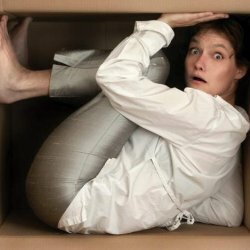Phobic disorders
 Phobic disorders are a set of disorders in which anxiety occurs in connection with certain situations or objects that present no danger at the present time. Due to the appearance of such a situation, a person experiences fear, and he tries to avoid it in all possible ways. The intensity of phobic anxiety can range from an almost palpable discomfort to panic.
Phobic disorders are a set of disorders in which anxiety occurs in connection with certain situations or objects that present no danger at the present time. Due to the appearance of such a situation, a person experiences fear, and he tries to avoid it in all possible ways. The intensity of phobic anxiety can range from an almost palpable discomfort to panic.
In some cases, the patient concentrates his fear on any symptom, such as nausea or rapid heartbeat, which often echoes secondary fears of death, loss of control or insanity. Consciousness that others do not consider the patient's situation dangerous, does not reduce the feeling of anxiety. Even the thought of the future occurrence of a phobic situation makes the patient worry.
About 10% of the population in their entire lives at least once experiences a panic attack. Multiple cases of anxiety, caused by phobic disorders, occur in about 1% of people. Apart from social phobias, women are twice as likely to suffer from different kinds of anxiety disorders than men.
Phobic disorders are divided into the following types:
- agoraphobia;
- social phobia;
- specific phobias.
Agoraphobia
Agoraphobia is a fear of being in a place that can not be quickly left or sheltered from the crowd. This term is also called fear of open space or crowded places. Once in a similar situation, the patient experiences severe anxiety. Some people feel anxious when they are in public places and public transport. The development of this type of phobia is observed due to the panic fear that arises in such situations. However, other patients simply feel uncomfortable, and anxiety increases gradually with the frequency of occurrence of agoraphobic situations. As a result, many patients try to avoid such cases, do not go out into the street, preferring to stay at home, as in a shelter.
Agoraphobia may be part of a panic disorder or may be manifested individually. Over a 12-month period, agoraphobia affects about 4% of women and 2% of men. Usually the disease begins at about the age of 20, but sometimes there are cases of illness after 40 years.
Social phobia
Social phobia is an alarm to be at the center of public attention, as well as fear of public speaking. Patients experience a strong sense of anxiety in such situations, so they try not to attract attention to themselves. Those suffering from social phobia realize that their fear is exaggerated and has no basis.
Anxiety can be the result of careless criticism from others. The embarrassment or humiliation felt by a person can lead to the development of social disorders. Before public speaking or just in dealing with people, many patients feel dizzy, vomit, blush or tremble. Often patients fear that their fear will be noticed by others, which greatly aggravates their anxiety. When communicating, they are afraid that they will not be able to clearly formulate their thoughts or answer questions of interest to the interlocutor.
The actions that the patient performs perfectly with himself are impeccable, become a problem in certain situations. Social phobia is expressed in patients not only with participation in speeches, but also in situations involving group activities, for example, eating in canteens or making applications in public institutions.
Social phobia for a 12-month period occurs in about 9% of women and 7% of men. Those who are ill throughout life, account for 13% of the total number of patients. Severe forms of disorders are found more often in men.
Specific phobia
A specific phobia is an anxiety caused by a specific situation or object. Fear of some patients is expressed in a panic attack, although many are fully aware of the futility and excessiveness of their anxiety.
The most common among the population are the following specific phobias: zoophobia( fear of animals), acrophobia( fear of heights), brontophobia( anxiety during thunder and thunder).Insectophobia( fear of insects) is also often observed among the population, especially in women. Some phobias adversely affect the life of a person. For example, claustrophobia( fear of enclosed spaces) disrupts the functioning of the patient - he is forced, because of fear, to avoid elevators and small rooms. People suffering from hemophobia( fear of blood), can lose consciousness at the sight of a scratch. Many patients sometimes completely isolate themselves from the outside world, trying to prevent the emergence of a situation that causes them anxiety.
This type of phobic disorder is observed more often than other types. Women are more prone to these anxiety disorders. Over a 12-month period, about 13% of women and 4% of men fall into specific phobias. More than 5% of the population to some extent have such disorders as hemophobia, trypanophobia( fear of injections) and traumatophobia( fear of physical damage).
Symptoms and pathogenesis of phobic disorders
Phobic disorders are characterized by a sense of intrusive anxiety when a particular situation arises. Fear is accompanied by autonomic dysfunction. Patients in any way try to avoid situations or objects that cause such feelings. Fear is purely conditional in nature - in the absence of anxious conditions it is not expressed.
Phobias manifest themselves like a conditioned reflex on a psychoasthenic constitutional basis. It is characterized by such features as emotionality, suspiciousness, shyness, anxiety. The beginning of phobic anxiety is preceded by a pathogenic situation, then fear arises from memories of it, after which it can turn into an obsessive fear.
Diagnosis and treatment of phobic disorders
A qualified psychiatrist can diagnose a phobic disorder. Communication with a doctor helps the patient to identify his fears, accompanied by autonomic dysfunction in certain situations. Often there is a phobic disorder on the basis of a depressive episode, especially often - agoraphobia.
To effectively treat phobic disorders, drug therapy is combined with psychotherapy. Of the drugs used tranquilizers( fenozipam, mebikar), antidepressants and nootropics. From psychotherapeutic methods use psychoanalysis, paradoxical intention, desentization( behavioral psychotherapy), neurolinguistic programming. Recently, in the treatment of specific phobias, also resort to methods of exposure therapy. Through a gradual addiction, the patient significantly reduces anxiety in front of the phobic situation. More than 90% of cases with this method of treatment have a positive result. In the treatment of agoraphobia and social phobia, a good result is achieved with the help of cognitive-behavioral therapy.



